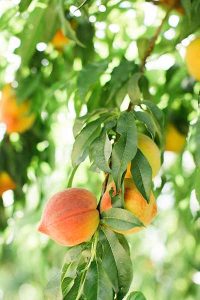Rich History of Georgia Peach
Since you’re looking for some ‘dirt on us’, we think it’s about time you got schooled about Georgia Peaches. Our history class goes way back!
 Though peaches were originally planted in St. Augustine, Fla., Franciscan monks introduced them to St. Simons and Cumberland islands along Georgia’s coast in 1571. By the mid-1700s peaches and plums were cultivated by the Cherokee Indians. Raphael Moses, a planter and Confederate officer from Columbus, was among the first to market peaches within Georgia in 1851 and is credited with being the first to ship and sell peaches successfully outside of the South. His method of shipping peaches in champagne baskets, rather than in pulverized charcoal, helped to preserve the flavor of the fruit and contributed to his success.
Though peaches were originally planted in St. Augustine, Fla., Franciscan monks introduced them to St. Simons and Cumberland islands along Georgia’s coast in 1571. By the mid-1700s peaches and plums were cultivated by the Cherokee Indians. Raphael Moses, a planter and Confederate officer from Columbus, was among the first to market peaches within Georgia in 1851 and is credited with being the first to ship and sell peaches successfully outside of the South. His method of shipping peaches in champagne baskets, rather than in pulverized charcoal, helped to preserve the flavor of the fruit and contributed to his success.
The first Georgia peaches were shipped to the New York market between 1858 and 1860. They were transported by wagon to Augusta, then by shallow-draft boat to Savannah, and finally by steamship to New York. Georgia earned its “Peach State” designation during the three decades following the Civil War.
Samuel Henry Rumph, a middle Georgia peach grower during the late 1800’s, is credited with being the “Father of the Georgia Peach industry” as he revolutionized the industry with a new variety which he named after his wife Elberta. This yellow-fleshed peach was of superior quality and shipped better than previous varieties. Not only did he breed this superior variety but he also invented a way to ice train cars loaded with peaches, thus getting this “Queen of Fruits” into the populous Northeast. Rumph never patented his Elberta peach or the refrigerated train car. Instead he opted to share this windfall with his neighbors and the “Georgia Peach Boom” began. Elberta remained the leading peach in Georgia until the 1960’s but newer varieties have since replaced the Elberta in commercial use. Although the Elberta remains the most famous peach name, Georgia now produces more than 40 commercial varieties, most of which have been bred from the Elberta.
Considerable expansion of peach acreage occurred in the late 19th and early 20th centuries, resulting in an all-time high production of almost eight million bushels by 1928. Since then production has decreased to about two million bushels annually.

